Analysis of Equality, Diversity, and Inclusion in the Workplace Report
VerifiedAdded on 2021/02/21
|11
|1767
|96
Report
AI Summary
This report delves into the crucial concepts of equality, diversity, and inclusion (EDI) within the workplace, defining each term and highlighting their interconnectedness. It explores the distinctions between equality, which emphasizes equal treatment, diversity, which values differences, and inclusion, which focuses on creating a sense of belonging. The report analyzes the impact of EDI on organizational policies, emphasizing the importance of treating all employees fairly and with respect. It outlines the consequences of breaching equality legislation, including potential legal ramifications. Furthermore, it defines the responsibilities of various stakeholders, including company directors, HR departments, managers, and employees, in fostering an inclusive environment. The report also examines different forms of discrimination and harassment, such as age, gender, and religious discrimination, and the characteristics of behaviors that support EDI. It stresses the importance of positive behaviors, teamwork, and open-mindedness in creating a productive and equitable workplace, and identifies key issues relating to EDI, like gender inequality and communication barriers. The report concludes by summarizing the significance of EDI and its impact on organizational success.
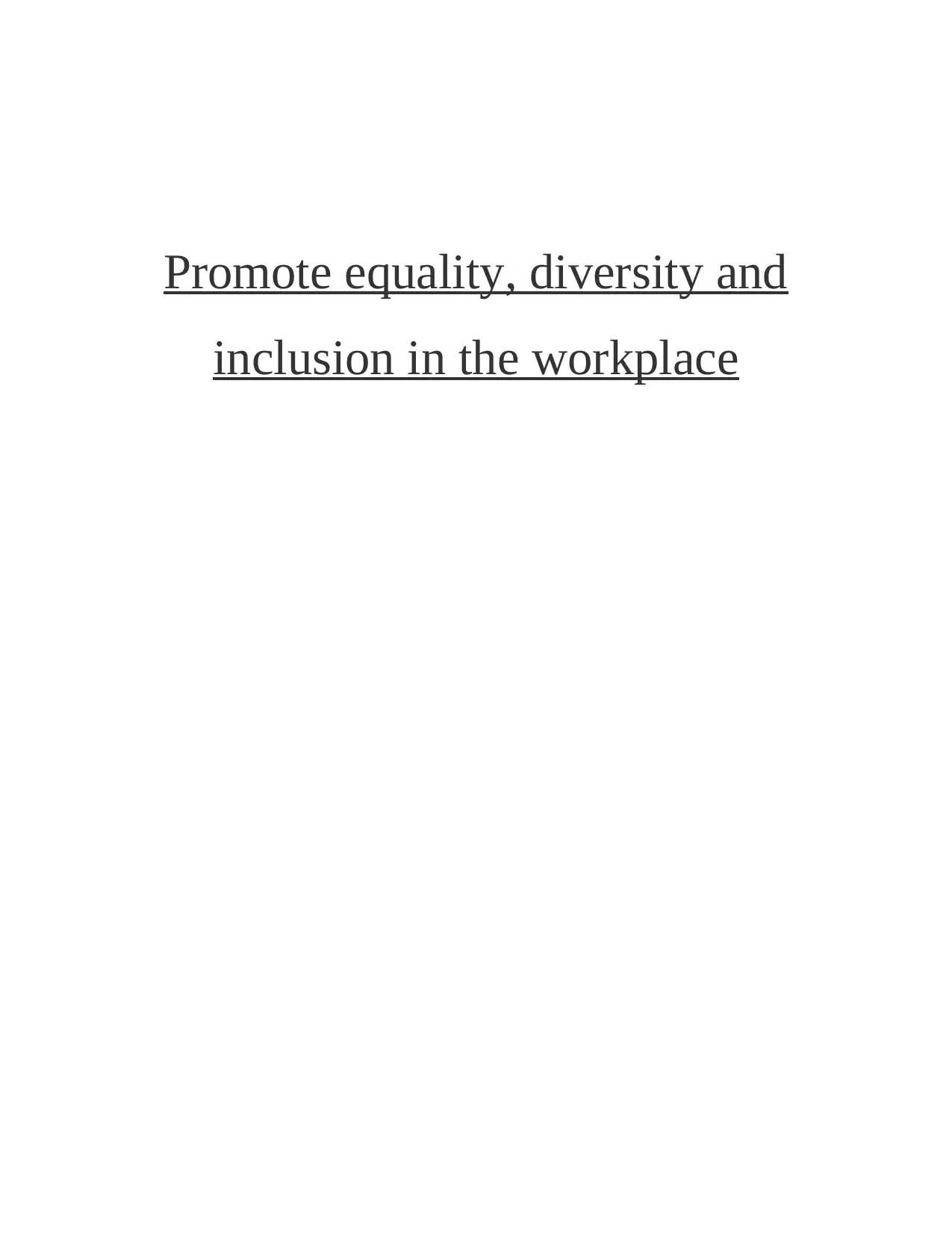
Promote equality, diversity and
inclusion in the workplace
inclusion in the workplace
Paraphrase This Document
Need a fresh take? Get an instant paraphrase of this document with our AI Paraphraser
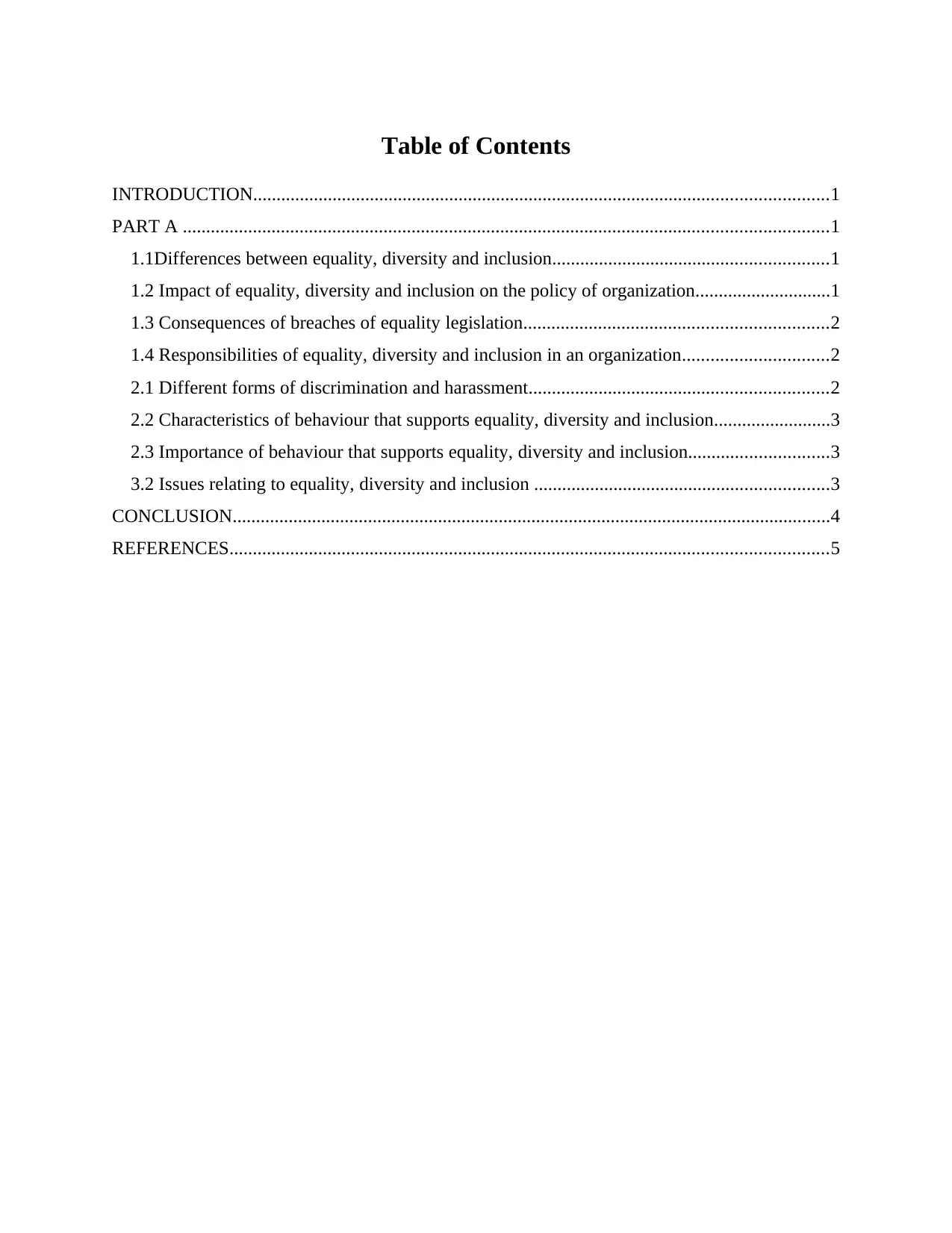
Table of Contents
INTRODUCTION...........................................................................................................................1
PART A ..........................................................................................................................................1
1.1Differences between equality, diversity and inclusion...........................................................1
1.2 Impact of equality, diversity and inclusion on the policy of organization.............................1
1.3 Consequences of breaches of equality legislation.................................................................2
1.4 Responsibilities of equality, diversity and inclusion in an organization...............................2
2.1 Different forms of discrimination and harassment................................................................2
2.2 Characteristics of behaviour that supports equality, diversity and inclusion.........................3
2.3 Importance of behaviour that supports equality, diversity and inclusion..............................3
3.2 Issues relating to equality, diversity and inclusion ...............................................................3
CONCLUSION................................................................................................................................4
REFERENCES................................................................................................................................5
INTRODUCTION...........................................................................................................................1
PART A ..........................................................................................................................................1
1.1Differences between equality, diversity and inclusion...........................................................1
1.2 Impact of equality, diversity and inclusion on the policy of organization.............................1
1.3 Consequences of breaches of equality legislation.................................................................2
1.4 Responsibilities of equality, diversity and inclusion in an organization...............................2
2.1 Different forms of discrimination and harassment................................................................2
2.2 Characteristics of behaviour that supports equality, diversity and inclusion.........................3
2.3 Importance of behaviour that supports equality, diversity and inclusion..............................3
3.2 Issues relating to equality, diversity and inclusion ...............................................................3
CONCLUSION................................................................................................................................4
REFERENCES................................................................................................................................5
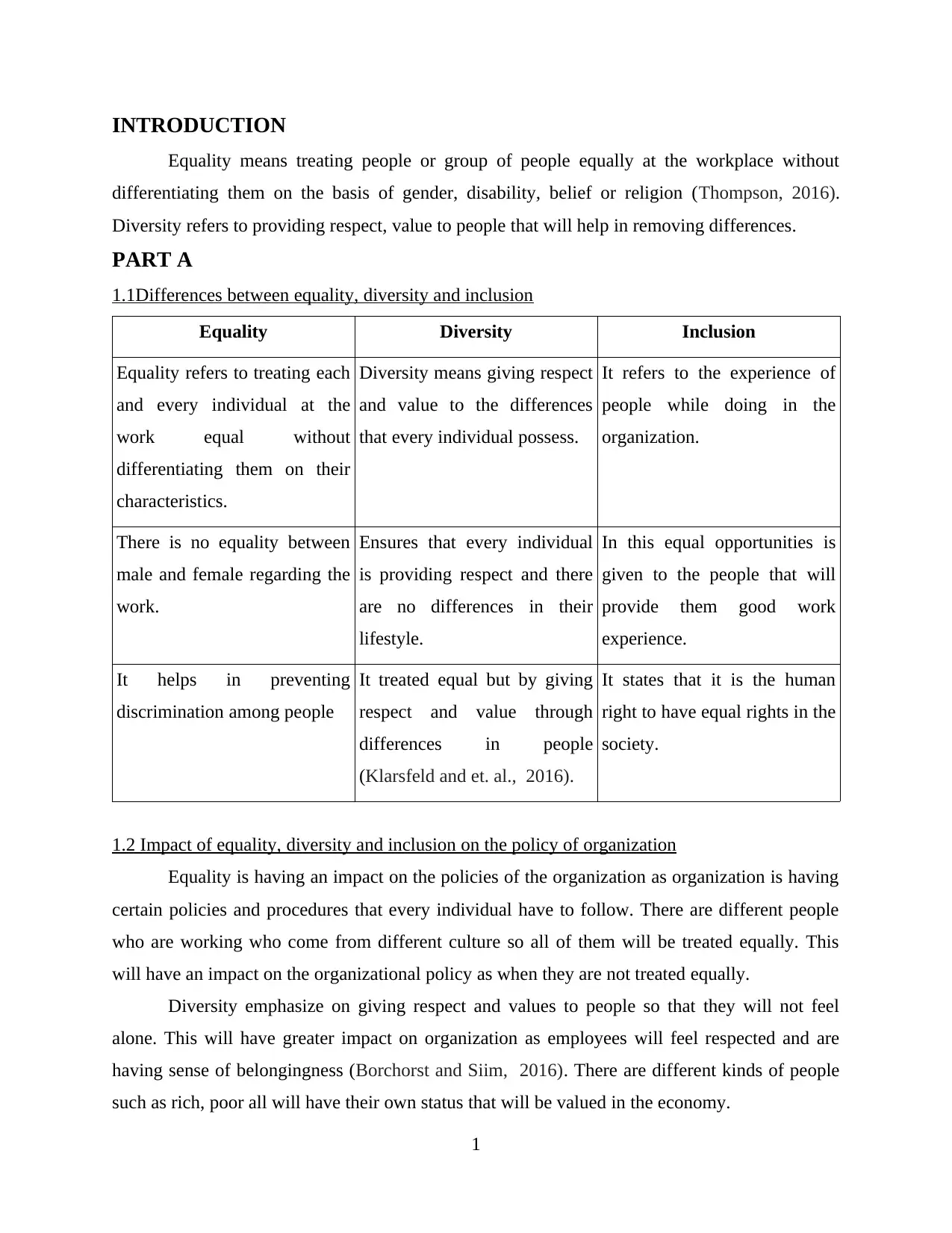
INTRODUCTION
Equality means treating people or group of people equally at the workplace without
differentiating them on the basis of gender, disability, belief or religion (Thompson, 2016).
Diversity refers to providing respect, value to people that will help in removing differences.
PART A
1.1Differences between equality, diversity and inclusion
Equality Diversity Inclusion
Equality refers to treating each
and every individual at the
work equal without
differentiating them on their
characteristics.
Diversity means giving respect
and value to the differences
that every individual possess.
It refers to the experience of
people while doing in the
organization.
There is no equality between
male and female regarding the
work.
Ensures that every individual
is providing respect and there
are no differences in their
lifestyle.
In this equal opportunities is
given to the people that will
provide them good work
experience.
It helps in preventing
discrimination among people
It treated equal but by giving
respect and value through
differences in people
(Klarsfeld and et. al., 2016).
It states that it is the human
right to have equal rights in the
society.
1.2 Impact of equality, diversity and inclusion on the policy of organization
Equality is having an impact on the policies of the organization as organization is having
certain policies and procedures that every individual have to follow. There are different people
who are working who come from different culture so all of them will be treated equally. This
will have an impact on the organizational policy as when they are not treated equally.
Diversity emphasize on giving respect and values to people so that they will not feel
alone. This will have greater impact on organization as employees will feel respected and are
having sense of belongingness (Borchorst and Siim, 2016). There are different kinds of people
such as rich, poor all will have their own status that will be valued in the economy.
1
Equality means treating people or group of people equally at the workplace without
differentiating them on the basis of gender, disability, belief or religion (Thompson, 2016).
Diversity refers to providing respect, value to people that will help in removing differences.
PART A
1.1Differences between equality, diversity and inclusion
Equality Diversity Inclusion
Equality refers to treating each
and every individual at the
work equal without
differentiating them on their
characteristics.
Diversity means giving respect
and value to the differences
that every individual possess.
It refers to the experience of
people while doing in the
organization.
There is no equality between
male and female regarding the
work.
Ensures that every individual
is providing respect and there
are no differences in their
lifestyle.
In this equal opportunities is
given to the people that will
provide them good work
experience.
It helps in preventing
discrimination among people
It treated equal but by giving
respect and value through
differences in people
(Klarsfeld and et. al., 2016).
It states that it is the human
right to have equal rights in the
society.
1.2 Impact of equality, diversity and inclusion on the policy of organization
Equality is having an impact on the policies of the organization as organization is having
certain policies and procedures that every individual have to follow. There are different people
who are working who come from different culture so all of them will be treated equally. This
will have an impact on the organizational policy as when they are not treated equally.
Diversity emphasize on giving respect and values to people so that they will not feel
alone. This will have greater impact on organization as employees will feel respected and are
having sense of belongingness (Borchorst and Siim, 2016). There are different kinds of people
such as rich, poor all will have their own status that will be valued in the economy.
1
⊘ This is a preview!⊘
Do you want full access?
Subscribe today to unlock all pages.

Trusted by 1+ million students worldwide
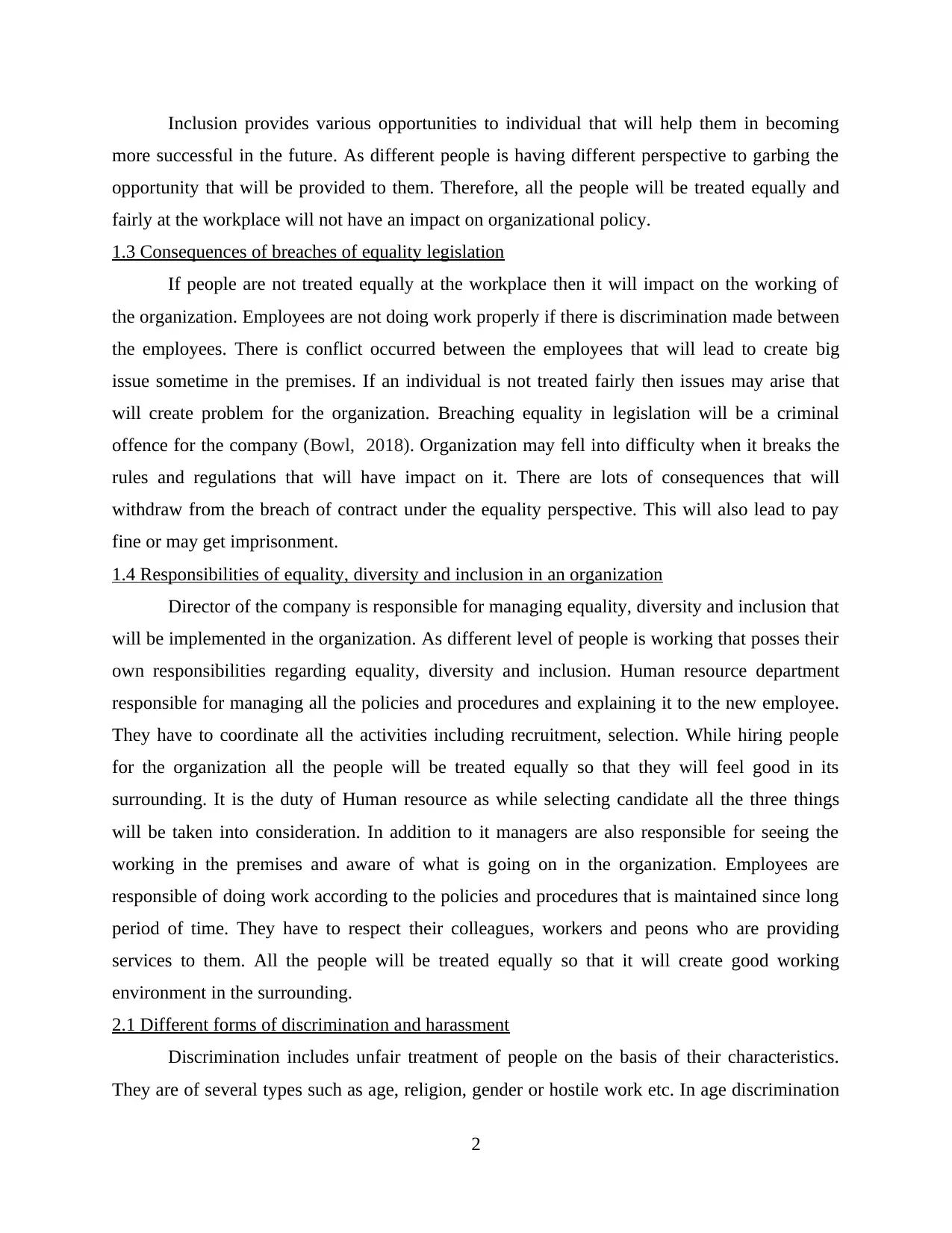
Inclusion provides various opportunities to individual that will help them in becoming
more successful in the future. As different people is having different perspective to garbing the
opportunity that will be provided to them. Therefore, all the people will be treated equally and
fairly at the workplace will not have an impact on organizational policy.
1.3 Consequences of breaches of equality legislation
If people are not treated equally at the workplace then it will impact on the working of
the organization. Employees are not doing work properly if there is discrimination made between
the employees. There is conflict occurred between the employees that will lead to create big
issue sometime in the premises. If an individual is not treated fairly then issues may arise that
will create problem for the organization. Breaching equality in legislation will be a criminal
offence for the company (Bowl, 2018). Organization may fell into difficulty when it breaks the
rules and regulations that will have impact on it. There are lots of consequences that will
withdraw from the breach of contract under the equality perspective. This will also lead to pay
fine or may get imprisonment.
1.4 Responsibilities of equality, diversity and inclusion in an organization
Director of the company is responsible for managing equality, diversity and inclusion that
will be implemented in the organization. As different level of people is working that posses their
own responsibilities regarding equality, diversity and inclusion. Human resource department
responsible for managing all the policies and procedures and explaining it to the new employee.
They have to coordinate all the activities including recruitment, selection. While hiring people
for the organization all the people will be treated equally so that they will feel good in its
surrounding. It is the duty of Human resource as while selecting candidate all the three things
will be taken into consideration. In addition to it managers are also responsible for seeing the
working in the premises and aware of what is going on in the organization. Employees are
responsible of doing work according to the policies and procedures that is maintained since long
period of time. They have to respect their colleagues, workers and peons who are providing
services to them. All the people will be treated equally so that it will create good working
environment in the surrounding.
2.1 Different forms of discrimination and harassment
Discrimination includes unfair treatment of people on the basis of their characteristics.
They are of several types such as age, religion, gender or hostile work etc. In age discrimination
2
more successful in the future. As different people is having different perspective to garbing the
opportunity that will be provided to them. Therefore, all the people will be treated equally and
fairly at the workplace will not have an impact on organizational policy.
1.3 Consequences of breaches of equality legislation
If people are not treated equally at the workplace then it will impact on the working of
the organization. Employees are not doing work properly if there is discrimination made between
the employees. There is conflict occurred between the employees that will lead to create big
issue sometime in the premises. If an individual is not treated fairly then issues may arise that
will create problem for the organization. Breaching equality in legislation will be a criminal
offence for the company (Bowl, 2018). Organization may fell into difficulty when it breaks the
rules and regulations that will have impact on it. There are lots of consequences that will
withdraw from the breach of contract under the equality perspective. This will also lead to pay
fine or may get imprisonment.
1.4 Responsibilities of equality, diversity and inclusion in an organization
Director of the company is responsible for managing equality, diversity and inclusion that
will be implemented in the organization. As different level of people is working that posses their
own responsibilities regarding equality, diversity and inclusion. Human resource department
responsible for managing all the policies and procedures and explaining it to the new employee.
They have to coordinate all the activities including recruitment, selection. While hiring people
for the organization all the people will be treated equally so that they will feel good in its
surrounding. It is the duty of Human resource as while selecting candidate all the three things
will be taken into consideration. In addition to it managers are also responsible for seeing the
working in the premises and aware of what is going on in the organization. Employees are
responsible of doing work according to the policies and procedures that is maintained since long
period of time. They have to respect their colleagues, workers and peons who are providing
services to them. All the people will be treated equally so that it will create good working
environment in the surrounding.
2.1 Different forms of discrimination and harassment
Discrimination includes unfair treatment of people on the basis of their characteristics.
They are of several types such as age, religion, gender or hostile work etc. In age discrimination
2
Paraphrase This Document
Need a fresh take? Get an instant paraphrase of this document with our AI Paraphraser
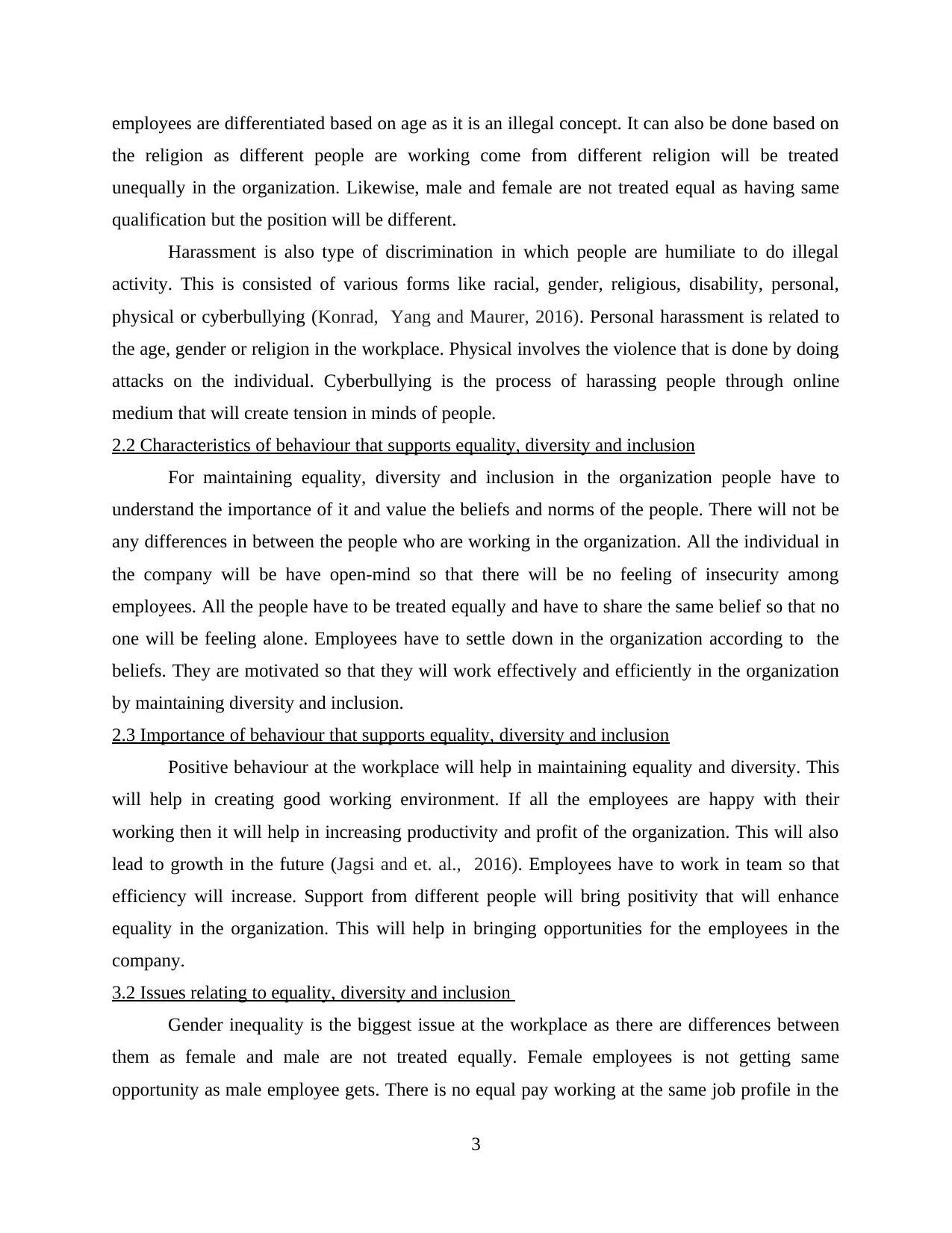
employees are differentiated based on age as it is an illegal concept. It can also be done based on
the religion as different people are working come from different religion will be treated
unequally in the organization. Likewise, male and female are not treated equal as having same
qualification but the position will be different.
Harassment is also type of discrimination in which people are humiliate to do illegal
activity. This is consisted of various forms like racial, gender, religious, disability, personal,
physical or cyberbullying (Konrad, Yang and Maurer, 2016). Personal harassment is related to
the age, gender or religion in the workplace. Physical involves the violence that is done by doing
attacks on the individual. Cyberbullying is the process of harassing people through online
medium that will create tension in minds of people.
2.2 Characteristics of behaviour that supports equality, diversity and inclusion
For maintaining equality, diversity and inclusion in the organization people have to
understand the importance of it and value the beliefs and norms of the people. There will not be
any differences in between the people who are working in the organization. All the individual in
the company will be have open-mind so that there will be no feeling of insecurity among
employees. All the people have to be treated equally and have to share the same belief so that no
one will be feeling alone. Employees have to settle down in the organization according to the
beliefs. They are motivated so that they will work effectively and efficiently in the organization
by maintaining diversity and inclusion.
2.3 Importance of behaviour that supports equality, diversity and inclusion
Positive behaviour at the workplace will help in maintaining equality and diversity. This
will help in creating good working environment. If all the employees are happy with their
working then it will help in increasing productivity and profit of the organization. This will also
lead to growth in the future (Jagsi and et. al., 2016). Employees have to work in team so that
efficiency will increase. Support from different people will bring positivity that will enhance
equality in the organization. This will help in bringing opportunities for the employees in the
company.
3.2 Issues relating to equality, diversity and inclusion
Gender inequality is the biggest issue at the workplace as there are differences between
them as female and male are not treated equally. Female employees is not getting same
opportunity as male employee gets. There is no equal pay working at the same job profile in the
3
the religion as different people are working come from different religion will be treated
unequally in the organization. Likewise, male and female are not treated equal as having same
qualification but the position will be different.
Harassment is also type of discrimination in which people are humiliate to do illegal
activity. This is consisted of various forms like racial, gender, religious, disability, personal,
physical or cyberbullying (Konrad, Yang and Maurer, 2016). Personal harassment is related to
the age, gender or religion in the workplace. Physical involves the violence that is done by doing
attacks on the individual. Cyberbullying is the process of harassing people through online
medium that will create tension in minds of people.
2.2 Characteristics of behaviour that supports equality, diversity and inclusion
For maintaining equality, diversity and inclusion in the organization people have to
understand the importance of it and value the beliefs and norms of the people. There will not be
any differences in between the people who are working in the organization. All the individual in
the company will be have open-mind so that there will be no feeling of insecurity among
employees. All the people have to be treated equally and have to share the same belief so that no
one will be feeling alone. Employees have to settle down in the organization according to the
beliefs. They are motivated so that they will work effectively and efficiently in the organization
by maintaining diversity and inclusion.
2.3 Importance of behaviour that supports equality, diversity and inclusion
Positive behaviour at the workplace will help in maintaining equality and diversity. This
will help in creating good working environment. If all the employees are happy with their
working then it will help in increasing productivity and profit of the organization. This will also
lead to growth in the future (Jagsi and et. al., 2016). Employees have to work in team so that
efficiency will increase. Support from different people will bring positivity that will enhance
equality in the organization. This will help in bringing opportunities for the employees in the
company.
3.2 Issues relating to equality, diversity and inclusion
Gender inequality is the biggest issue at the workplace as there are differences between
them as female and male are not treated equally. Female employees is not getting same
opportunity as male employee gets. There is no equal pay working at the same job profile in the
3
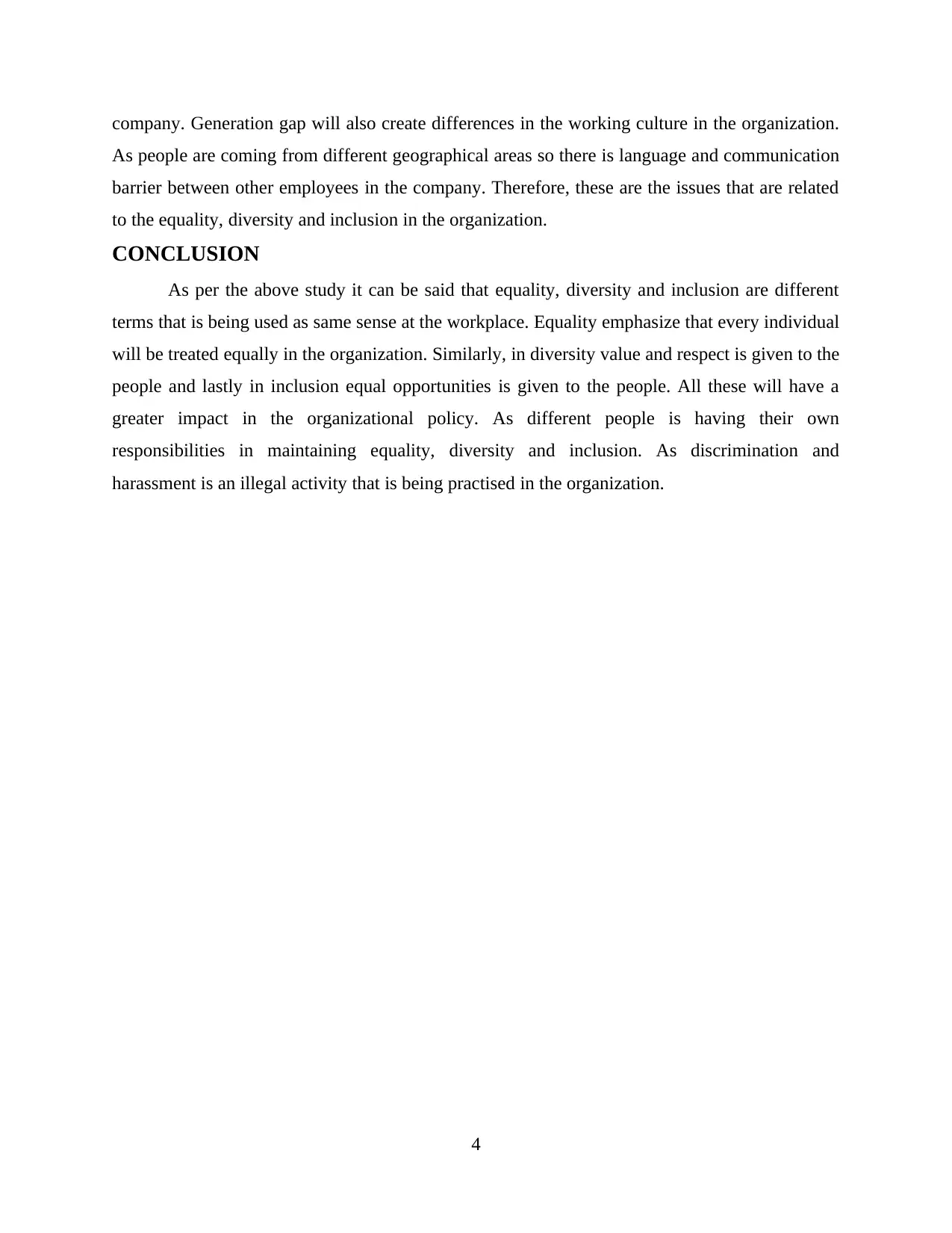
company. Generation gap will also create differences in the working culture in the organization.
As people are coming from different geographical areas so there is language and communication
barrier between other employees in the company. Therefore, these are the issues that are related
to the equality, diversity and inclusion in the organization.
CONCLUSION
As per the above study it can be said that equality, diversity and inclusion are different
terms that is being used as same sense at the workplace. Equality emphasize that every individual
will be treated equally in the organization. Similarly, in diversity value and respect is given to the
people and lastly in inclusion equal opportunities is given to the people. All these will have a
greater impact in the organizational policy. As different people is having their own
responsibilities in maintaining equality, diversity and inclusion. As discrimination and
harassment is an illegal activity that is being practised in the organization.
4
As people are coming from different geographical areas so there is language and communication
barrier between other employees in the company. Therefore, these are the issues that are related
to the equality, diversity and inclusion in the organization.
CONCLUSION
As per the above study it can be said that equality, diversity and inclusion are different
terms that is being used as same sense at the workplace. Equality emphasize that every individual
will be treated equally in the organization. Similarly, in diversity value and respect is given to the
people and lastly in inclusion equal opportunities is given to the people. All these will have a
greater impact in the organizational policy. As different people is having their own
responsibilities in maintaining equality, diversity and inclusion. As discrimination and
harassment is an illegal activity that is being practised in the organization.
4
⊘ This is a preview!⊘
Do you want full access?
Subscribe today to unlock all pages.

Trusted by 1+ million students worldwide
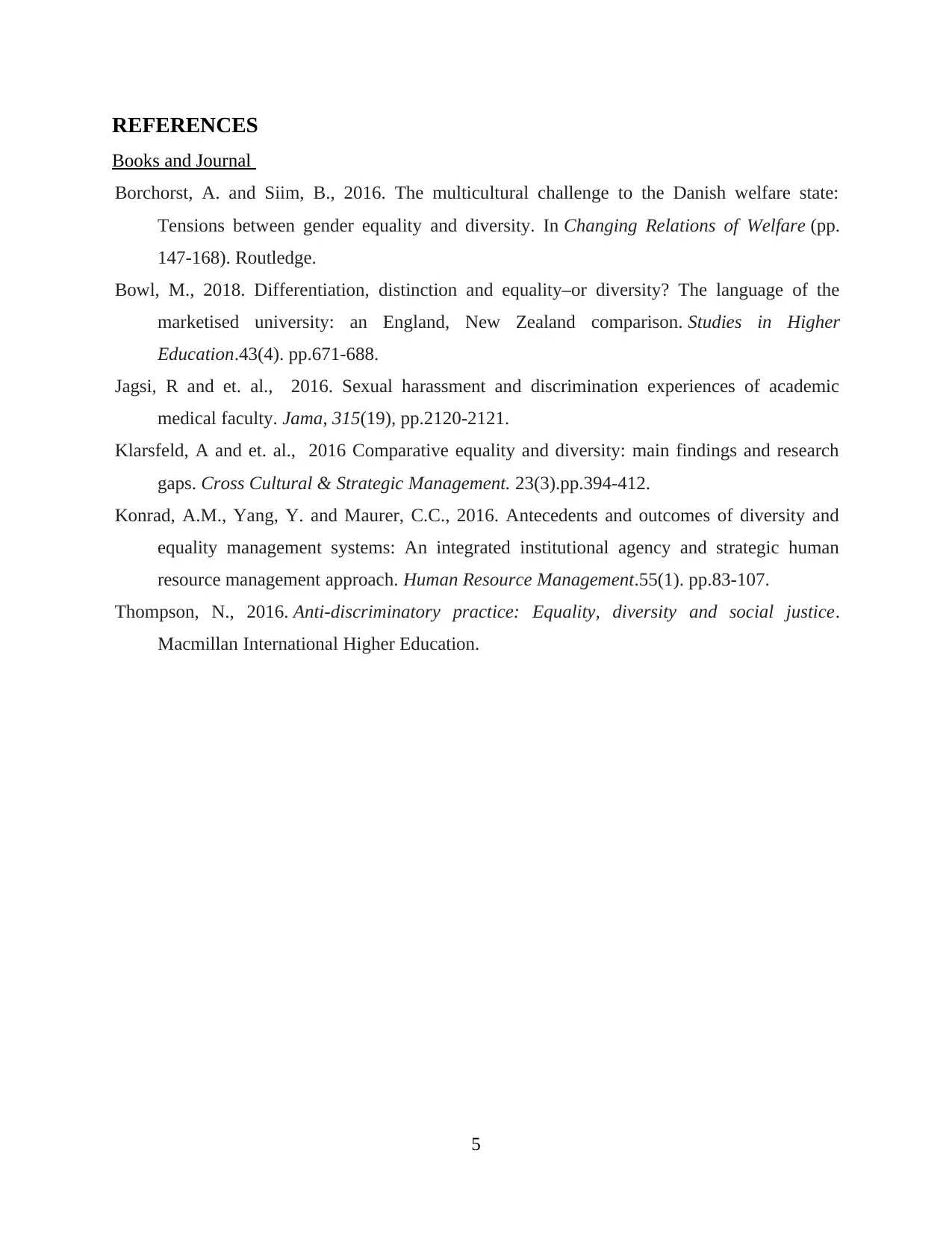
REFERENCES
Books and Journal
Borchorst, A. and Siim, B., 2016. The multicultural challenge to the Danish welfare state:
Tensions between gender equality and diversity. In Changing Relations of Welfare (pp.
147-168). Routledge.
Bowl, M., 2018. Differentiation, distinction and equality–or diversity? The language of the
marketised university: an England, New Zealand comparison. Studies in Higher
Education.43(4). pp.671-688.
Jagsi, R and et. al., 2016. Sexual harassment and discrimination experiences of academic
medical faculty. Jama, 315(19), pp.2120-2121.
Klarsfeld, A and et. al., 2016 Comparative equality and diversity: main findings and research
gaps. Cross Cultural & Strategic Management. 23(3).pp.394-412.
Konrad, A.M., Yang, Y. and Maurer, C.C., 2016. Antecedents and outcomes of diversity and
equality management systems: An integrated institutional agency and strategic human
resource management approach. Human Resource Management.55(1). pp.83-107.
Thompson, N., 2016. Anti-discriminatory practice: Equality, diversity and social justice.
Macmillan International Higher Education.
5
Books and Journal
Borchorst, A. and Siim, B., 2016. The multicultural challenge to the Danish welfare state:
Tensions between gender equality and diversity. In Changing Relations of Welfare (pp.
147-168). Routledge.
Bowl, M., 2018. Differentiation, distinction and equality–or diversity? The language of the
marketised university: an England, New Zealand comparison. Studies in Higher
Education.43(4). pp.671-688.
Jagsi, R and et. al., 2016. Sexual harassment and discrimination experiences of academic
medical faculty. Jama, 315(19), pp.2120-2121.
Klarsfeld, A and et. al., 2016 Comparative equality and diversity: main findings and research
gaps. Cross Cultural & Strategic Management. 23(3).pp.394-412.
Konrad, A.M., Yang, Y. and Maurer, C.C., 2016. Antecedents and outcomes of diversity and
equality management systems: An integrated institutional agency and strategic human
resource management approach. Human Resource Management.55(1). pp.83-107.
Thompson, N., 2016. Anti-discriminatory practice: Equality, diversity and social justice.
Macmillan International Higher Education.
5
Paraphrase This Document
Need a fresh take? Get an instant paraphrase of this document with our AI Paraphraser

6

7
⊘ This is a preview!⊘
Do you want full access?
Subscribe today to unlock all pages.

Trusted by 1+ million students worldwide

8
Paraphrase This Document
Need a fresh take? Get an instant paraphrase of this document with our AI Paraphraser

9
1 out of 11
Related Documents
Your All-in-One AI-Powered Toolkit for Academic Success.
+13062052269
info@desklib.com
Available 24*7 on WhatsApp / Email
![[object Object]](/_next/static/media/star-bottom.7253800d.svg)
Unlock your academic potential
Copyright © 2020–2025 A2Z Services. All Rights Reserved. Developed and managed by ZUCOL.





